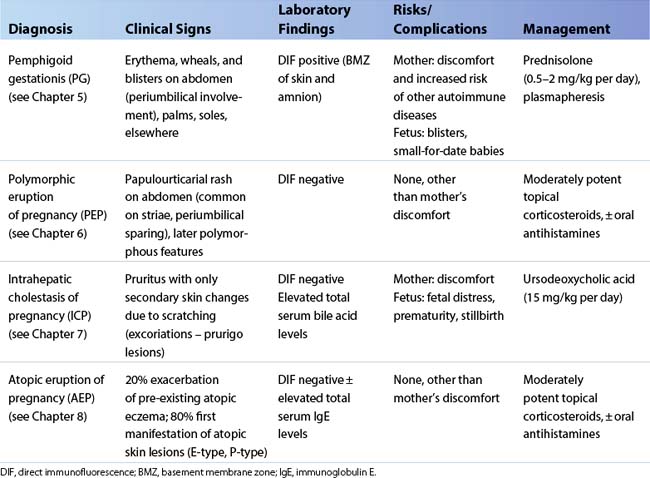CHAPTER 4 A Systematic Approach to the Dermatoses of Pregnancy
Introduction
Cutaneous symptoms and signs are not uncommon during pregnancy. The physiologic signs of pregnancy (see Chapter 3) often involve the skin or mucous membranes, and can sometimes provide contributory evidence of pregnancy.
Although pruritus is the principal cutaneous symptom in pregnancy, itching in itself is not diagnostically helpful. Thus, a full clinical history and a thorough clinical examination are essential to confirm, or exclude, the possibility of any coexisting dermatosis or infestation. The clinical implications of pruritus in pregnancy are outlined in Table 4.1. Chapter 10 describes the effect of pregnancy on other skin disorders. This chapter considers the difficult nomenclature of the specific dermatoses of pregnancy.
Table 4.1 Clinical Implications of Pruritus in Pregnancy
| Normal skin (‘pruritus gravidarum’) |
| Pre-existing skin condition |
| Skin condition coincidentally acquired in pregnancy |
| Specific dermatoses of pregnancy |
Historical background
The specific dermatoses of pregnancy represent a heterogeneous group of severely pruritic inflammatory dermatoses closely related to pregnancy and/or the immediate postpartum period. For decades, they have caused great diagnostic confusion. Prior to 1982, the terminology became increasingly confused, with several names being used for similar clinical conditions 1–10(Tables 4.2 and 4.3). The authors have extensively reviewed all the existing literature and have studied a large group of patients comprehensively, covering all the existing disease entities. Similar work was done by Holmes and Black before they published their proposals in 198211 and 198312 of a simplified clinical classification of the specific dermatoses of pregnancy. This classification subdivided the specific dermatoses of pregnancy into four groups: (1) pemphigoid (herpes) gestationis (PG); (2) polymorphic eruption of pregnancy (PEP; synonymous: pruritic urticarial papules and plaques of pregnancy, PUPPP); (3) prurigo of pregnancy (PP); and (4) pruritic folliculitis of pregnancy (PF). Whereas in the United States the terms “herpes gestationis” and PUPPP are still preferred, in Europe the names PG (points to the autoimmune pathogenesis and avoids any possible association with herpesvirus) and PEP (points to the morphological spectrum) are widely accepted. Unfortunately, except for PG, no reliable criteria exist to differentiate the specific dermatoses of pregnancy13.
Table 4.2 Historical List of Specific Dermatoses of Pregnancy as Described by Various Authors
| Disorder | Reference | Year |
|---|---|---|
| Herpes gestationis | Milton1 | 1872 |
| Herpes impetigiformis (impetigo herpetiformis) | Hebra2 | 1872 |
| Prurigo gestationis | Besnier et al.3 | 1904 |
| Erythema multiforme | Gross4 | 1931 |
| Prurigo annularis | Davis5 | 1941 |
| Toxemic rash of pregnancy | Bourne6 | 1962 |
| Papular dermatitis of pregnancy | Spangler et al.7 | 1962 |
| Early- and late-onset prurigo of pregnancy | Nurse8 | 1968 |
| Pruritic urticarial papules and plaques of pregnancy | Lawley et al.9 | 1979 |
| Pruritic folliculitis of pregnancy | Zoberman and Farmer10 | 1981 |
From time to time “new” disease entities have been reported in the literature, but to date they have remained essentially anecdotal single case reports. Impetigo herpetiformis, for example, is now considered to be a variant of pustular psoriasis (see also Chapter 10). Alcalay et al.14
Stay updated, free articles. Join our Telegram channel

Full access? Get Clinical Tree









